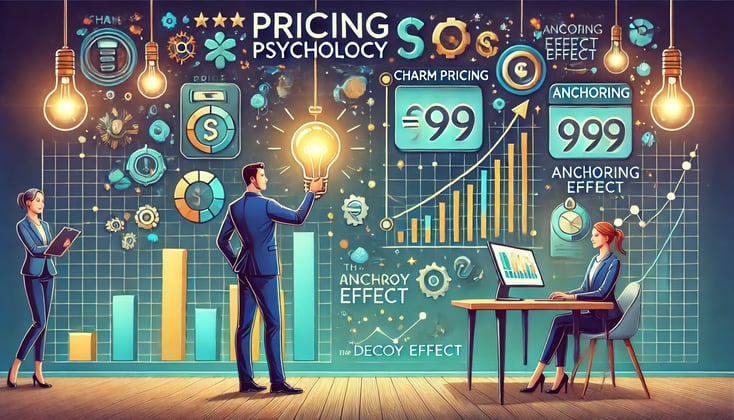The Psychology of Pricing: How to Set Prices That Sell
Uncover the secrets of pricing psychology and learn how strategies like charm pricing, anchoring, and the decoy effect influence customer decisions. This blog offers actionable insights to set prices that sell and build stronger connections with your audience.
Astitva Dubey
11/27/20243 min read


The Magic of ₹99
Have you ever wondered why so many products are priced at ₹99 instead of ₹100? It’s not just a coincidence or a marketing gimmick—it’s psychology at work. I remember the first time I read about this in a business class; it blew my mind. The concept, known as "charm pricing," makes prices feel smaller than they actually are, even though the difference is just one rupee.
As a second-year business student, I’ve come to realize that pricing isn’t just about numbers. It’s about emotions, perceptions, and decisions. Let me share what I’ve learned about pricing psychology and how businesses use it to sell effectively.
The Role of Psychology in Pricing
1. Charm Pricing: The ₹99 Effect
Let’s start with the obvious one. Prices ending in 9 have been proven to boost sales. This happens because people read from left to right, so ₹999 feels closer to ₹900 than ₹1000, even though it’s just one rupee less.
A study published in the journal Quantitative Marketing and Economics found that charm pricing increased sales by up to 24%. Think about that next time you see a “₹99” price tag!
Takeaway: If you’re pricing products, consider ending them in 9, but use it strategically—too many “₹99” products can cheapen your brand.
2. Anchoring: The Power of Comparison
Here’s a personal anecdote: Last month, I was shopping for a laptop. The website displayed three options—₹50,000, ₹70,000, and ₹1,00,000. Guess which one I picked? The ₹70,000 one, because it felt like the “best value.”
This is anchoring in action. By presenting a high-priced option first, businesses make mid-range options feel more reasonable. Anchoring works because humans rely on the first piece of information they see (the “anchor”) to make decisions.
A famous example is Apple. When they launched the iPad, they first showed a price of $999, then revealed it was actually $499. Customers perceived it as a bargain, thanks to the higher anchor.
Takeaway: Always display a higher-priced option first to make your mid-range products look more attractive.
3. The Decoy Effect: Guiding Choices
Imagine this: You’re at a coffee shop, and there are three options—Small for ₹100, Medium for ₹150, and Large for ₹160. Most people choose Large because it feels like a better deal than Medium. That’s the decoy effect.
This pricing strategy uses a deliberately less attractive option (the decoy) to nudge customers toward a specific choice. In my opinion, it’s one of the smartest pricing tricks because it subtly guides decisions without the customer realizing it.
A study by MIT confirmed this effect when testing subscription plans for The Economist. Adding a decoy option increased the sales of their more expensive plan by 43%.
Takeaway: If you’re offering multiple products or services, introduce a decoy to steer customers toward your most profitable option.
Making Pricing Relatable to Your Customers
1. Emphasize Value, Not Cost
I think one of the biggest mistakes businesses make is focusing too much on the price tag and not enough on the value. For example, instead of saying “₹200 per month,” say “Just ₹6.67 per day”—suddenly, it feels like a small expense.
2. Use Free Offers Wisely
People love “free.” In fact, the word itself can trigger emotional responses. Remember when Jio offered free data plans in India? It wasn’t just a promotion; it was a strategy to hook users.
However, free offers should complement your pricing strategy. For instance, offering a free trial can build trust, but you must ensure it leads to conversions later.
The Emotional Side of Pricing
What I’ve learned is that pricing is deeply emotional. Customers don’t just look at numbers; they think about what those numbers represent—status, convenience, or even self-worth.
For example, luxury brands like Gucci don’t rely on charm pricing or discounts because their customers value exclusivity. Instead, they use “prestige pricing,” where higher prices signal quality and status.
On the other hand, startups and budget-friendly brands often focus on affordability, using psychological pricing to make products feel accessible.
Fun Fact: A study in The Journal of Consumer Research found that customers are more likely to buy products priced at ₹299 than ₹300, even though the difference is just one rupee.
Conclusion: What I’ve Learned About Pricing Psychology
In my opinion, pricing isn’t just a number—it’s a story you tell your customers. Whether you’re using charm pricing to make products feel cheaper, anchoring to guide decisions, or the decoy effect to nudge choices, the goal is to align your prices with customer perceptions.
If you’re an entrepreneur or planning a side hustle, start experimenting with these strategies. The next time you price something, think about the emotions and behaviors behind it. Because in business, the right price isn’t just about profit—it’s about connection.
